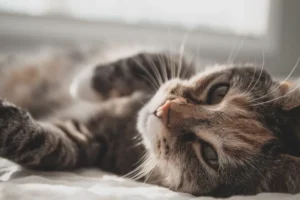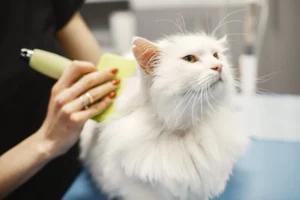Is your cat turning into a little dictator, demanding your attention, food, and playtime at every turn? It can be frustrating to deal with a demanding feline, but there are reasons behind this behavior. Understanding why your cat is so demanding can help you address the root cause and create a harmonious relationship with your furry friend.
If you’re wondering, “Why is my cat demanding everything?” the answer lies in their natural instincts and communication style. Cats are creatures of habit and routine, and they rely on you for their basic needs. When your cat demands attention, food, or play, they may be trying to communicate their needs or simply seeking interaction with you. By understanding the reasons behind their behavior, you can better respond to their demands and strengthen your bond with your cat.
Instincts at Play
Cats are innately creatures of habit. They thrive on routine and predictability in their environment, which can often translate to demanding behavior when their needs are not being met. By providing a consistent daily routine for your feline friend, you can help alleviate some of their neediness.
Security is another key instinct driving your cat’s demanding behavior. Cats are territorial animals and seek out safe spaces where they feel protected. If your cat is constantly seeking attention or clinging to you, it may be a sign that they are looking for reassurance and security. Creating cozy hideaways and safe spots for your cat to retreat to can help fulfill this need.
Social interaction is also a crucial aspect of a cat’s behavior. Cats are not solitary creatures and rely on social bonds for companionship and stimulation. If your cat is demanding your attention, it may be a sign that they are craving more social interaction. Spending quality time playing, grooming, and simply being present with your cat can help meet this need and reduce their neediness.
Communication Cues
Cats have a variety of ways to communicate their needs and desires to their human companions. Vocalizations are one of the most common forms of communication, with each meow, purr, or chirp conveying a different message. Paying attention to the pitch, volume, and frequency of your cat’s meows can help you understand what they are trying to communicate.
Body language is another important communication tool for cats. Tail position, ear position, and eye contact all play a role in conveying your cat’s emotions and intentions. A cat with a puffed-up tail and flattened ears may be feeling fearful or aggressive, while a cat with relaxed body language and slow blinking eyes is likely feeling content and relaxed.
By learning to interpret your cat’s vocalizations and body language, you can better understand their needs and respond accordingly. This can help reduce their demanding behavior and strengthen the bond between you and your furry companion.
Environmental Enrichment
Cats can become demanding when they are bored or not mentally stimulated enough. Providing toys, scratching posts, and interactive play sessions can help keep your cat engaged and prevent them from seeking constant attention. Creating vertical spaces like cat trees or shelves can also give your cat a sense of territory, reducing their need to demand things from you. Remember, a happy and fulfilled cat is less likely to exhibit demanding behavior.
To enhance your cat’s environment further, consider adding puzzle feeders or treat-dispensing toys to encourage mental stimulation during meal times. Additionally, rotating toys and introducing new ones periodically can keep your cat mentally engaged and prevent them from getting bored. Engaging your cat in play sessions that mimic hunting behavior, such as using wand toys or laser pointers, can also provide physical and mental exercise that satisfies their innate instincts.
To learn more about enhancing your cat’s environment, you can explore this resource on environmental enrichment for cats: Cat Environmental Enrichment Guide
Establishing Boundaries
Setting clear boundaries with your cat is essential in preventing them from becoming overly demanding. Consistency is key when establishing rules, such as not rewarding demanding behavior with attention or treats. Redirecting your cat’s attention to a designated play area or providing interactive toys when they get too demanding can help reinforce these boundaries.
When your cat displays demanding behavior, avoid giving in to their requests right away. Instead, wait for a calm moment to offer attention or treats. By establishing boundaries and enforcing them consistently, you can communicate to your cat what behavior is acceptable and avoid reinforcing demanding tendencies.
In addition to setting boundaries, providing positive reinforcement and rewards for good behavior can encourage your cat to follow the rules. Praising and treating your cat when they exhibit desirable behavior can help reinforce these positive habits and create a healthier dynamic between you and your feline friend. Remember, patience and consistency are key when it comes to establishing boundaries with your cat.
Mental Stimulation
Cats demand attention when they’re bored or understimulated. Just like humans, they need mental stimulation to thrive. Interactive play, puzzle feeders, and rotating toys can keep your cat entertained and prevent them from constantly seeking your attention. Try engaging them in activities that mimic their natural hunting instincts to satisfy their need for mental engagement. Remember, a stimulated cat is a happy cat!
Routine and Consistency
Maintaining a consistent schedule for feeding, playtime, and interaction can work wonders in reducing your cat’s demands for attention. Cats thrive on routine and feel secure when they know what to expect. By establishing a daily schedule and sticking to it, you can help reassure your cat and prevent them from constantly vying for your time and attention. Consistency is key in keeping your feline friend content and less demanding.
Additional Unique Insight: Consider setting up designated playtimes throughout the day to meet your cat’s need for interaction. This structured approach can help establish boundaries and create a balanced routine for both you and your furry companion. By incorporating regular play sessions into your daily schedule, you can provide your cat with the attention they crave while still maintaining a healthy balance in your relationship.
Seeking Veterinary Advice
If your cat is demanding everything, it may be time to seek professional guidance from a veterinarian or animal behaviorist. Persistent demanding behavior could be a sign of an underlying medical issue that needs to be addressed. A vet can help rule out any health concerns and provide guidance on how to manage your cat’s behavior effectively.
By understanding the root cause of your cat’s demands, a vet or behaviorist can tailor a plan to meet your cat’s specific needs. Whether it’s addressing anxiety, boredom, or a lack of stimulation, professional guidance can make a significant difference in creating a harmonious relationship with your feline friend. Remember, seeking help is a proactive step towards providing the best care for your cat.
Understand your Cat’s Emotional Needs
When your cat seems to be demanding everything, it could be a cry for attention or a signal that they are not getting their emotional needs met. Cats are sentient beings with complex emotions, and their behavior is often a reflection of how they feel.
Ensure your cat has a stimulating environment with plenty of opportunities for play, exploration, and social interaction. Sometimes, something as simple as spending quality time with your cat or providing new toys can make a world of difference. Understanding and meeting your cat’s emotional needs is key to fostering a strong bond and preventing demanding behavior.
Establish a Routine
Cats thrive on routine and predictability. Creating a consistent daily schedule for feeding, playtime, and rest can help reduce demanding behavior. By establishing a routine, your cat knows what to expect and feels more secure in their environment.
Ensure your cat has access to food, water, and a comfortable litter box at all times. Incorporate interactive play sessions into your daily routine to provide mental and physical stimulation. Consistency and structure can help alleviate your cat’s demands and promote a sense of security and well-being.
Additional Insight: Consider Environmental Enrichment
In addition to meeting your cat’s basic needs, consider environmental enrichment to keep your cat stimulated and engaged. Provide vertical space for climbing, scratching posts, hiding spots, and interactive toys to prevent boredom and reduce demanding behavior. Creating a stimulating environment can help satisfy your cat’s natural instincts and promote mental and physical well-being.
Alex, a passionate animal lover, has experience in training and understanding animal behavior. As a proud pet parent to two dogs and three cats, he founded AnimalReport.net to share insights from animal experts and expand his knowledge of the animal kingdom.




